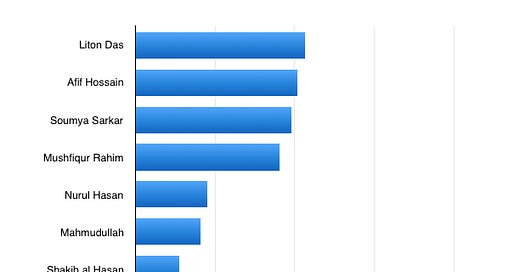When watching Bangladesh vs Scotland yesterday, I was reminded of the famous quote which states “tis better to have loved and lost than never to have loved at all”. The reason why Bangladesh’s chase reminded me of this quote was because their innings took the ‘never to have loved at all’ approach - they were defeated via a slow death, a death by 120 cuts if you want to use a T20 context, as opposed to taking a risk and giving themselves a chance at least.
Scotland’s approach was markedly different. From 53-6 after 69 balls, they understood the key point that in their remaining 51 balls, it was basically pointless nurdling their way to a run a ball and posting around 105. To give themselves a chance, they had to continue hitting. Chris Greaves’ 45 from 28, including four fours and two sixes, plus some very useful high strike rate lower order cameos - how often have I mentioned the benefit of these - instead got them to a total of 140, which gave them at least some chance of defending.
In Scotland’s innings, they hit nine fours and six sixes - 15 boundaries. Despite the best efforts of the lower order, this is still pretty low, just 12.5% of balls faced - around 4% below the general T20 mean in most tournaments these days. The benefit of chasing is that Bangladesh knew how many boundaries Scotland scored and could, in theory, therefore pace their innings.
Instead, they didn’t.
When Mushfiqur Rahim was dismissed at 74-4 after a team total of 79 balls bowled, Bangladesh had hit just five boundaries (6.33%). To beat Scotland’s 15 boundaries (remember, around 85% of teams win the match with a higher boundary percentage than their opposition), they subsequently needed to hit 11 boundaries in 41 balls (26.83%) - a figure that would probably have even been beyond Andre Russell.
My view is clear - this was a hugely mismanaged chase. A T20 team simply cannot hit five boundaries in 79 balls. Shakib al Hasan (1 boundary from 28 balls, and Mushfiqur Rahim (3 boundaries from 36) were the obvious culprits here. Essentially, Bangladesh never gave themselves a chance and only some punishing hitting from Safyaan Sharif’s final over, when the match was as good as already lost, made the chase look closer than it actually was.
With this considered, let’s look at the boundary hitting numbers from Bangladesh’s top seven batters in T20 cricket from 2019 onwards (major T20 leagues and T20 internationals):-
It is apparent here that boundary-hitting is a clear issue for Bangladesh. Only Liton Das and Afif Hossain can be considered above-average hitters (and only just), with boundary percentages above 17%, while the likes of Nurul Hasan, and the experienced duo of Mahmudullah and Shakib al Hasan being far below average hitters.
The same story can be told when considering six-hitting, via the same sample period:-
Only Soumya Sarkar has hit sixes in over 5% of balls faced, and again, only just - and even his numbers are below what many other batters in international teams can offer. Shakib al Hasan again shows a hitting deficiency, and for all his all-rounder prowess in other formats, it’s difficult to state that he adds any value with the bat in T20 cricket, and his innings was a clear issue in yesterday’s chase too.
Looking at the above charts, it’s clear that Bangladesh lack a batting group capable of above-average, or even average, boundary-hitting. Still, a 140 chase shouldn’t have been beyond them if managed well, but they are really going to struggle to win the boundary percentage count in matches which involve bigger chases, unless their bowling performs outstandingly well - and this is a major problem for them moving forward.
To conclude, I noticed something else when watching the match yesterday. Bangladesh seemed to have a large overseas group of support staff, which presumably isn’t cheap. I’d venture to suggest that a slightly different or complementary approach would offer greater return on investment - pay for a specific hitting coach to work with their setup, from their national team down to age group cricket. Bangladesh will have no choice but to develop hitters if they are ever to become a major threat in T20 cricket on the world stage away from low-scoring conditions away from home, and this investment would make a lot of sense in my view.
Perhaps also, they might want to hire an analyst to tell them this stuff as well. Based on yesterday’s evidence, they either don’t have one, or they aren’t listened to.





Hi Dan. I think your analysis is spot on and I think Bangladesh just meandered to the end outcome. Another point I would like your input on. Coming into this World Cup they played on low, slow, turning tracks and really did not challenge their batters into either creating or chasing bigger totals (though the score that Scotland put on was neither big nor hugely challenging). I also saw the huge midwicket swipe or the ridiculous dil scoop being the only preferred option to get those big hits. This actually played right into Scotland's plan and some grey matter could have been used by the Bangladesh batters in the areas in which they tried to get the boundaries.